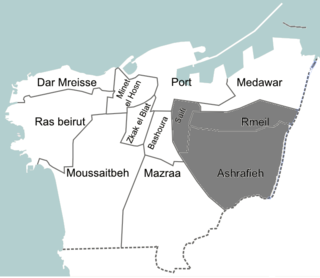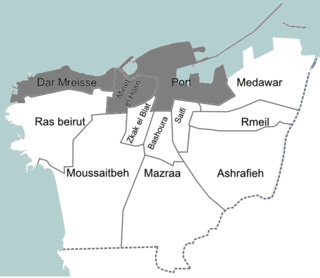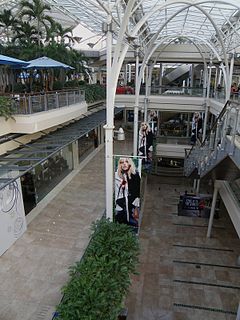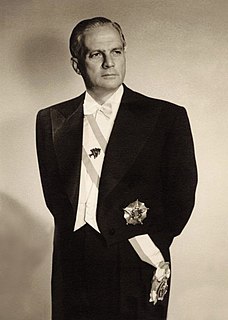
Beirut I was an electoral district in Lebanon. It covered three neighbourhoods (quartiers) in the eastern parts of the capital; Achrafieh, Rmeil and Saifi. The constituency elected five members of the Parliament of Lebanon; one Maronite, one Greek Orthodox, one Greek Catholic, one Armenian Orthodox and one Armenian Catholic. The constituency was created with the 2008 Doha Agreement, ahead of the 2009 parliamentary election.

Beirut II was a parliamentary constituency in Lebanon. It covered three neighbourhoods (quartiers) in the north-eastern parts of the capital; Port, Medawar and Bachoura. The constituency elected four members of the National Assembly. Two of the Beirut II MPs had to be Armenian Orthodox, 1 Sunni Muslim and 1 Shia Muslim. The constituency was created with the 2008 Doha Agreement, ahead of the 2009 parliamentary election.

Beirut III was an electoral district in Lebanon. It covered six neighbourhoods (quartiers) in the western parts of the capital; Dar El Mreisse, Mazraa, Minet El Hosn, Moussaitbeh, Ras Beirut and Zuqaq al-Blat. The constituency elected ten members of the Parliament of Lebanon; five Sunni Muslim, one Shia Muslim, one Druze, one Protestant, one Greek Orthodox and one Minorities. The constituency was created with the 2008 Doha Agreement, ahead of the 2009 parliamentary election.
Voting to elect eight members of the Lebanese parliament took place in the Beirut I district on March 24, 1968, part of the national general election of that year. The constituency had 98,439 eligible voters, out of whom 28,631 voted. The elections in Beirut I passed smoothly without violent incidents.
Voting to elect five members of the Lebanese parliament took place in the Beirut III district on March 24, 1968, part of the national general election of that year. The constituency had 75,296 eligible voters, out of whom 30,713 voted.
Voting to elect four members of the Lebanese parliament took place in the Akkar District in 1968, part of the national general election of that year. Two of the seats of the constituency were earmarked for the Sunni Muslim community, one seat for the Greek Orthodox and one for the Maronites. Akkar was the most underdeveloped area of northern Lebanon, politically dominated by landlords. The elections were marred by accusations of vote-buying and minor violent incidents. The constituency had 71,899 eligible voters, out of whom 30,282 voted.
Voting to elect eight members of the Lebanese parliament took place in Chouf District on April 7, 1968, as part of the national general election of that year. Three of the seats of the constituency were earmarked for the Maronite community, two for the Sunni Muslim, two for the Druze whilst the last seat was allocated to the Greek Catholics. The Chouf District constituency had 78,557 eligible voters, out of whom 46,056 voted. All in all Chouf District was one of the most hotly contested constituencies in the election, being the home turf of Camille Chamoun and Kamal Jumblatt. The situation in the constituency was tense, but the polls went through without violent incidents. However, Jumblatt did accuse 'a large embassy in Beirut' of buying votes for Chamoun.

Vahan Papazian, also known by his pseudonym Goms (Կոմս) was an Armenian political activist and a community leader in Van, a member of the Armenian Revolutionary Federation.

Beirut II was a parliamentary constituency in Lebanon. It covered three neighbourhoods (quartiers) of the capital; Dar El Mreisse, Zuqaq al-Blat and Bachoura. Michael Hudson described Beirut II as a 'small "catch-all" district'. This constituency was used in the 1960, 1964, 1968 and 1972 elections.
Haratch ('Forward') was an Armenian language weekly newspaper published from Beirut, Lebanon 1957-1970. Founded in January 1957, it was an organ of the Lebanese Communist Party. It stopped publication in 1970.

In Lebanese politics Minorities is a term that includes six different Christian sects; Syriac Orthodox, Syriac Catholics, Assyrian Church of the East, Chaldean Catholics, Latin Catholics and Coptic Orthodox. 1 of the 128 seats in the national parliament is allocated to Minorities. The Minorities' seat is elected from Beirut III electoral district, an electoral district with a large Sunni Muslim majority.
Abdallah Ishak was a Lebanese Armenian Catholic politician. Ishak hailed from the pre-1915 Armenian diaspora in Lebanon. In 1929 he defeated Ayoub Tabet and was elected to the Lebanese Parliament from the Beirut Minorities seat with the support from Maronite and Armenian groups. He was the first Armenian parliamentarian in Lebanon.

Beirut V – Minet El Hosn was an electoral district in Lebanon, used in the 1953 parliamentary election. The electoral district covered three neighbourhoods of Beirut and elected a Minorities parliamentarian. Joseph Chader of the Kataeb Party was elected from the district in 1953.
Chafic Nassif was a Lebanese politician and lawyer.
Joseph Chader was a Lebanese Armenian Catholic politician. He was a Member of Parliament between 1951 and 1977, and served as deputy speaker at times. In 1958 he became the first Armenian government minister in Lebanon. He served as vice chairman of the Kataeb Party.

Bint Jbeil electoral district was an electoral district in Lebanon. It covered all areas of the Bint Jbeil District. The constituency elected three Shia Muslim members of the Parliament of Lebanon.
The Bourj Hammoud electoral district or the Eight Constituency was an electoral district in Lebanon, used in the 1953 parliamentary election. The district elected a single Armenian Orthodox parliamentarian.
Artin Madoyan was a Lebanese-Armenian communist politician. He was the most prominent Armenian leader of the Lebanese Communist Party. He was seen as the 'right hand' of Syrian communist leader Khalid Bakdash.
Sebouh Kalpakian is a Lebanese Armenian politician. Kalpakian served as the chairman of the Lebanon Executive Board of the Social Democrat Hunchakian Party for thirteen years. However, he left this position and emigrated to Australia, but ahead of the 2009 Lebanese general election he returned to Lebanon to run for parliament. The Ministry of Interior and Municipalities declared Kalpakian elected unopposed on April 22, 2009.
A total of 583 candidates contested the 2018 Lebanese general election, running on 77 lists.













